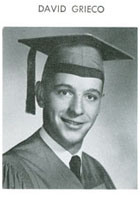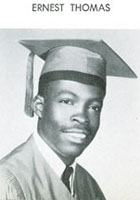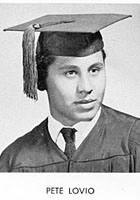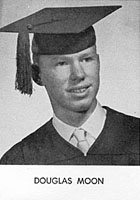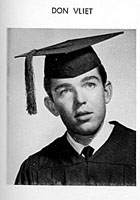Lancaster, California
We'd lived in Clairemont for almost a year when Dad came home one evening and announce, "We're moving." This time we were heading up to Lancaster, California in the Mojave Desert.
[...] Our first home there was another duplex close to the center of town. We lived in that duplex for a year until Dad figured out that we could afford a brand new house in a development on the edge of town that was close to the high school. The address was 45438 Third Street.
In 1956 we went to Lancaster, California. [...] After Mom's mother passed on, the money she inherited was used to purchase a tract home. It was on Third Street.
Lancaster was a boomtown then. There was a huge influx of technical employees (guys like my Dad) who had dragged their families into this godforsaken place in order to work on the missile projects at Edwards Air Force Base.
Frank Zappa of Lancaster, son of Mr. and Mrs. Frank Zappa, 45438 Third St. East.
So this is 3rd Street East, I think. It's the name of it. This is the street Frank lived on. He was living here when I first met him in 1957. [...] I believe Frank's house is this one. 45504. That garage is where he had his drums set up.
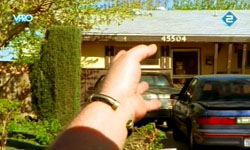
Denny Walley was born in Pennsylvania in 1944. His family moved to Brooklyn when he was a toddler and then to Lancaster, California, in the mid-1950s, when his father, an aircraft mechanic, was sent to work at Edwards Air Force Base. The move was a good one. "I was 12 going on 13, and we moved into the same housing development that Frank Zappa lived in," Walley says. "I became best friends with Frank's brother Bobby. We had a common interest in blues records—the early blues 45s—and Frank was a big collector. I would go over there and Frank would play those records."
Around age 12, my parents moved from New York to Lancaster California. We lived in a new housing development called Tamarack Fair and, by coincidence, the Zappa family lived in the same development. I became best friends with Frank's younger brother, Bobby. The first time I ever heard the blues was in Bobby and Frank's bedroom, and I was hooked.
1956-1958—Antelope Valley High School, Lancaster
Ernie [Tosi] first met Frank [Zappa] in the fall of 1956, when Frank came in from San Diego.
Zappa has immortalized in books, interviews and on album covers the names of Antelope Valley High School faculty members Ernest Tosi, Jerry Murnane, William Ballard, Don Cerveris and [...] Amy Heydorn.
Kim Rawley, "Nothing But Noise And Drums," Antelope Valley Press, September, 2003
Candy [Zappa] recalls Frank saying that AV High gave him his diploma "so they wouldn't have to deal with him anymore." Indeed, his altercations with the now-deceased administrator, Ernest Tosi, became the stuff of legend, and RoseMarie [Zappa] remembers her husband having to go to the school to deal with Frank's misbehavior. But the classroom of English teacher Don Cerveris, who played piano himself, provided a haven for Frank, according to Candy.
David Read, "Exclusive Interview With Frank Zappa," Oswego County Times, November 2-8, 1972
OCT: Where did you go to high school?
Zappa: Antelope Valley Joint Union High School & Junior College, A.V.J.U.H.S. we called it.
OCT: Did you play any sports there?
Zappa: I was in the corrective physical education program because I had asthma. I played a lot of badminton and ping-pong.
c. 1956—Films
FZ's letter to Edgard Varèse, August, 1957, from Felix Meyer (ed.), Edgard Varèse, Composer, Sound Sculptor, Visionary, The Boydell Press, 2006, p. 403-404
I paint in oils and watercolor and last year produced a cartoon film in school by painting color directly onto a 250 foot reel of cleared 16 mm movie film. I painted on the color in such a way that I managed to closely, but not completely, synchronize their movements to your "DENSITY 21.5" and the second "movement" of "OCTANDRE". It brought about some amazing results from the audience and my counselors in the office allowed me to make a trip I had planned to Walt Disney studios with the film.
1957—Antelope Valley Junior College
FZ's letter to Edgard Varèse, August, 1957, from Felix Meyer (ed.), Edgard Varèse, Composer, Sound Sculptor, Visionary, The Boydell Press, 2006, p. 403-404
Nothing ever came of my trip [to Walt Disney studios], but when I got back to school I was informed I had a chance to be skipped from the Junior year in high school to the Freshman year at the junior college which adjoined the school as an experiment.
I went to the Jaycee and studied harmony and music appreciation and history for one semester and came out of it with A's and B's.
When I was in High School they kept throwing me out. [...] So they had this junior college nearby and they would send me up there a couple days a week to take a course of music in the junior college while I was still in hight school. It was so stupid you know. They would show you well here is your exercise for the day, write this choral and it's got to sound just like Bach—big deal. So you are writing a hymn tune—who is that fellow?—It doesn't even make you feel like you are learning music. So I garbaged my way through that for awhile and I didn't retain very much of it.
My formal musical education consists of one special harmony course which I was allowed to take during my senior year in high school . . . another harmony course (with required keyboard practice) . . . and a composition course at Pomona College which I would sneak into and audit.
[FZ] was allowed to take a special harmony course during his senior year given by Mr. Russell at Antelope Valley Junior College. [...] "I figured I wanted to get laid but when I went to find somebody to stuff it up, they were all going to school. [...] You know there's no loose nook so I figured, 'Let's be practical, lad' so I enrolled at Antelope Valley Junior College." [...] That lasted for a little less than a semester.
When I was in high school, I was one of these incorrigible people, and to shut me up they figured, "Well, maybe he just likes music." So, since the high school I was going to didn't offer any theory classes, they would send me over to the junior college for an hour a day to take this theory class there. And it was taught by a jazz trumpeter named Mr. Russell, and we were working out of the Walter Piston harmony book. I did my little exercises in there for one semester, then I had maybe one semester at a junior college after that. But that's the extent of my formal training. The rest of it's all from the library.
FZ, interviewed by Don Menn, Zappa!, 1992
The harmony training I got was because I was an unruly senior in high school, and they gave me permission to take some harmony classes at the adjoining junior college. They figured that the reason why I was such a delinquent was because my mind wasn't occupied. So they let me take this course at the junior college while I was senior. The guy who was teaching it was a guy named Mr. Russell, who was a jazz trumpet player, and I don't think that he enjoyed harmony very much either, but that's what he was teaching. I could have said to him, "Hey, some chords shouldn't resolve." And he would probably say, "Yeah, but you'll get a D if you don't resolve them."
Mr. Ballard, The High School Orchestra And Choir
1958 Yucca Yearbook
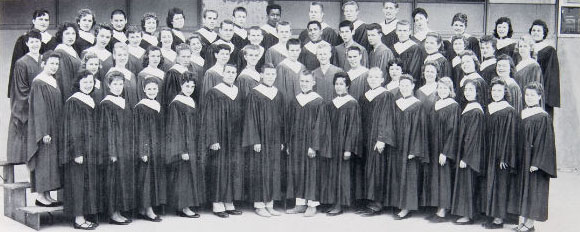
[...] Row 3: [...] Wayne Lyles [...]
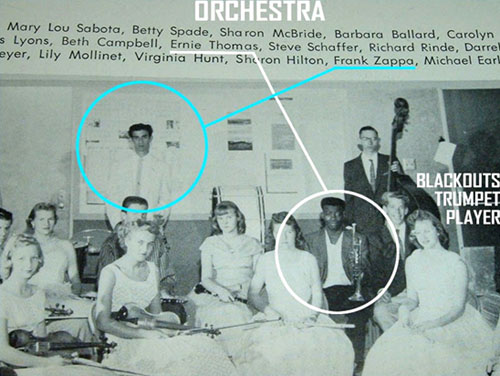
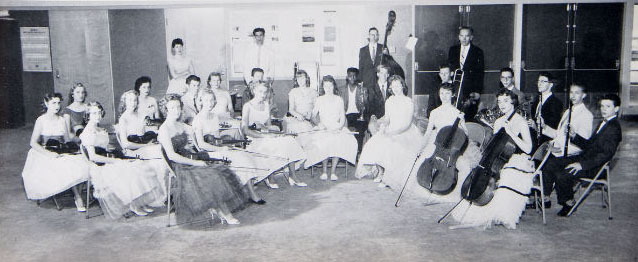
First row: Ruth Livenmore, Sharon Wilson, Mary Lou Sabota, Betty Spade, Sharon McBride, Barbara Ballard, Carolyn Kyle. Second row: Ruth Baines, Judy Roach, Jance Humble, Joan Kidd, Charles Lyons, Beth Campbell, Ernie Thomas, Steve Schaffer, Richard Rinde, Darrel Simpson, David Randell, Russell Mills, Jerry Simpson. Third row: Gwen Beckemeyer, Lily Mollinet, Virginia Hunt, Sharon Hilton, Frank Zappa, Michael Earls, Mr. Ballard.
As a kid, I knew Frank very well. We played in the school's band and orchestra together. Frank and I were probably the only music "readers" in the group.
In Lancaster I went to the high school. In 1955 I started to practice the piano. By then I played in the school band not only harmonica but also a trumpet and a tuba. At the age of fifteen I had my first performance with a country and western band playing boogie woogie style on the piano that was also recorded for one radio station.
Known as 'Butch' at school, the teenage Alexis Clair Snouffer, had a reputation around Lancaster as a tough nut. He wasn't someone you messed with. Playing trumpet in the high school band he befriended the drummer, Frank Zappa. Within a short time both had acquired guitars and were furiously practising so they could play the R&B and blues music they both liked.
Pierre Perrone, London Independent, January, 2006
Born in 1941, Alexis Clair Snouffer grew up in Lancaster, California, and played trumpet in the Antelope Valley High School band, where he met Frank Zappa, who was on drums. By the late Fifties, both Snouffer and Zappa had moved on to guitar, were playing rhythm'n'blues covers in various bands and hanging out with their friend Don Van Vliet.
It started when I first met Frank. We were in the High School senior band together. He was playing drums and I played trumpet. He was a drummer. He wasn't always a guitarist. Anyway, we met, got to know each other a little bit. I suppose that it was probably within two weeks of each other we both got a guitar and started learning how to play the motherfucker. It was back in those days when if you could play Honky Tonk in ALL THREE CHANGES, hey, you were probably the best guitar man in the valley. We both were basically self-taught as far as that was concerned.
At Antelope Valley high School, his music teacher Mr. Ballard allowed him to conduct the orchestra, a job to which he brought a typically experimental approach. "A high school orchestra in those days tuned up a box which put out a tone. It had two switches, A and B flat. The B flat was used for tuning up the marching band, and the orchestra tuned to the A. So I took the first violins and tuned them to the A, and took the second violins and tuned them to B flat, guaranteeing that whatever they played would be dissonant, no matter what was on the page. "Another thing was, he had these musical staves on the blackboard, and he would let me write out these completely dense chords on the blackboard and tell all the different musicians which note of the chords was going to be theirs, then just conduct a downbeat to hear these chords. Some of them were so dense it just sounded like wind—there wasn't even any harmony coming out. But how are you going to find out what these things would sound like if you don't get a chance to hear them played by instruments? He saved me a lot of effort in later life just by letting me hear things like that. Of course, the other people in the orchestra thought I was out of my fucking mind."
Mr. Ballard was the high school music instructor at Antelope Valley High. He let me conduct the orchestra a couple of times, let me write music on the blackboard, and had the orchestra play it.
Mr. Ballard also did me a big favor without knowing it. As a drummer, I was obliged to perform the gruesome task of playing in the marching band. Considering my lack of interest in football, I couldn't stand sitting around in a stupid-looking uniform, going 'Da-ta-da-da-ta-ta-taaaah; CHARGE!" every time somebody kicked a fucking football, freezing my nards off every weekend. Mr. Ballard threw me out of the marching band for smoking in uniform—and for that I will be eternally grateful.
"I had no outlet in music then to express my discontent. So my aggravation with the way things were festered throughout my high-school years. The only reason I got training as a musician was because the school needed a marching band at its football games. It was just another tool to support the sports program. I never did enjoy sports. So I looked at all that and thought that there certainly must be more worthwhile educational investments besides new helmets. That really got me thinking—how can you take any of this seriously?"
Fortunately for Zappa, his tenure with the band didn't last long. "I was thrown out for smoking in uniform," he says while taking a drag from one of many Marlboros he would smoke that afternoon. "We had to sit in the freezing cold and wear these dorky maroon-and-gray uniforms and play every time our team scored a touchdown. So, during a break, I went under the bleachers for a smoke. I got caught and I was out of there. Not just for smoking, but for smoking in uniform."
I really have to thank Mr. Ballard (his high school music teacher) for tossing me out of the band—for smoking in uniform. Imagine that. I didn't want to be in the friggin' marching band anyway. But if you're a drummer, what do you do? What are you gonna do? Wear the hat with the chingus on the front. And it was an ugly uniform, it was maroon and grey—uuuhhh, man. Uuuuggghh. Smelly, uuuhhh, hands are cold trying to play rubbidy dub dub on an ugly sounding drum, marching, watching people play football and having to go 'Yeah!' Give me a fuckin' break. Thank you Mr. Ballard. God bless you, Mr. Ballard.
[...] I marched in parades. I hated every minute of it, but I also hated school, so it was just all one thing.
Ballard was actually sympathetic towards Frank and helped him in other ways. Zappa could never properly asess his musical compositions unless he heard them, so Ballard arranged for the school orchestra to play them. Frank wrote out the parts in chalk on the blackboard and, with him conducting, his bewildered schoolmates played their way through "The String Quartet," a composition that included the pieces known eleven years later as "Sleeping In A Jar" and "A Pound For A Brown On The Bus" when they appeared on Uncle Meat.
The First Guitar
I didn't hear any guitarists until I was about 15 or so, because in those days the saxophone was the instrument that was happening on record. When you heard a guitar player it was always a treat—so I went out collecting R&B guitar records. The solos were never long enough—they only gave them one chorus, and I figured the only way I was going to get to hear enough of what I wanted to hear was to get an instrument and play it myself. So I got one for a buck-fifty in an auction—and arch-top, f-hole, cracked base, unknown-brand thing, because the whole finish had been sanded off. It looked like it had been sandblasted. The strings were about, oh, a good inch off the fingerboard [laughs], and I didn't know any chords, but I started playing lines right way. Then I started figuring out chords and finally got a Mickey Baker book and learned a bunch of chords off that.
[...] My father played guitar when he was in college. He had an old one sitting around the house, but it didn't feel as good to me as the one for a buck-fifty. He played it about once every three years; he'd pick it up and go wank-wank-wank, but that was about all.
FZ, interviewed by Ralph Denyer, Sound International, April/May, 1979
I changed to guitar when I was in Senior High School. My brother had bought this guitar for a dollar-fifty at an auction. He wasn't using it much so I started messing around on it. By that time I had gathered a bunch of records. You know, on most records in those days the instrumental or solos were always played by saxophone. It was very rarely that you would hear a good guitar solo but I searched around and found some. I thought: I really want to do that, make those sort of noises. The guitar I had to begin with wasn't electric, just one of those arched-top f-hole models. I didn't know any chords, I just started playing Blues straight away.
[...] From the very beginning when I used to hear those solos on those old records I used to say: Now here is an instrument that is capable of spewing forth true obscenity, you know? If ever there's an obscene noise to be made on an instrument it's going to come out of a guitar. On a saxophone you can play sleaze. On a bass you can play balls. But on a guitar you can be truly obscene. And that is the extent of my belief in obscenity; as far as verbal obscenity is concerned, I think that is a fantasy. But really, actually, the guitar is capable of blasphemy. Let's be realistic about this, the guitar can be the single most blasphemous device on the face of the earth. That's why I like it.
FZ, interviewed by Guitarist Magazine, June, 1993
It had been kinda sandblasted! My brother got it for $1.50 at an auction and it was an archtop, f-hole, ugly motherfucker with the strings about a half-inch off the fingerboard. I liked it because it was so tinny-sounding. It was just an acoustic guitar, but it was moving closer to that wiry tone I liked with Johnny Guitar Watson, especially if you picked it right next to the bridge.
Jim Sherwood, interviewed by Billy James, T'Mershi Duween Magazine, June 1993
Frank used to sit out on the front lawn at the high school when I was a freshman and he had this old beat-up guitar. It was an old acoustic, with the frets really high. It had been in a fire and was all burnt up. I think his uncle gave it to him. Frank used to sit out and play all the time, because he was in sophomore year (that's the second one in England) and didn't have any classes, so he'd sit out and play guitar most of the time.
I found out later on that Bobby Zappa was in one of my classes. Bobby found out that I collected blues records and he introduced me to Frank, and Frank and I sort of got together and swapped records. We've been friends ever since. This was in 1956.
That's how Frank and I got in touch with each other, because I collected blues records at the time. Frank was working at [...] the record store in town [...]. Bobby (Frank's brother) took me over to the house to meet Frank and look at his record collection. Frank and I just hit it off. We were comparing blues records and songs and all that kind of stuff.
August, 1957—The Composer
FZ's letter to Edgard Varèse, August, 1957, from Felix Meyer (ed.), Edgard Varèse, Composer, Sound Sculptor, Visionary, The Boydell Press, 2006, p. 403-404
I have been composing for two years now, utilizing a strict twelve-tone technique, producing effects that are reminiscent of Anton Webern.
During those two years I have written two short woodwind quartets and a short symphony for winds, brass and percussion.
c. 1957-1958—The Blackouts
I was getting ready to catch a bus to go home, at Antelope Valley High, and one of my classmates, Wayne Riles [Lyles], came up and said, "Hey man, this guy's startin' a band, are you interested in getting in?" Wayne knew that I had this old saxophone that I'd been playing around with for a couple years. He said, "The guy's name is Frank Zappa." I said, "Frank who?"—I'd never heard a name like that before back at that time. So he invited me to come to a rehearsal in the old Boy's Gym. So, that's my first time ever seeing Frank. [...] He had his drums set up there and I brought my little horn in. I don't know who else was there. Wayne [Lyles] at that time was our vocalist, and he played bongos. [...] So anyway—I don't know if I can put chronology to this or not—but others started joining the group. Ernie Thomas, aah, Walley [Salazar], Fred [Salazar]. [The guy that played baritone,] Jerry Reuter!
FZ's letter to Edgard Varèse, August, 1957, from Felix Meyer (ed.), Edgard Varèse, Composer, Sound Sculptor, Visionary, The Boydell Press, 2006, p. 403-404
Recently I have been earning my keep at home with my blues band, the BLACKOUTS. We have done quite well and in my association with my fellow musicians I am learning to play other instruments besides drums.
When I was in high school, in Lancaster, I formed my first band, the Black-Outs. [...] This was the only R&B band in the entire Mojave Desert at that time. Three of the guys (Johnny Franklin, Carter Franklin and Wayne Lyles) were black, the Salazar brothers were Mexican and Terry Wimberly represented the other oppressed peoples of the earth.
Jerry Reutter, July 10, 2007
The band Frank was associated with prior to coming to Lancaster was a group called the 'Del Vikings' from San Diego. I remember it only because we had a battle of the bands with them and they cleaned our clock!
Frank had formed a band at that time called "The Blackouts" and he would often call Mom and ask her to pick him up from rehearsal.
Lancaster Women's Club
I can remember the first professional job I had with The Blackouts. We played in Lancaster—we were little kids. It was '57, I believe it was. Did it at a place called Lancaster Women's Club or something like that. [Corner of J and 10th.] I can remember, being kids, we all made $8 a piece (proudly). When you really figured out the time we put into it, we played four sets at forty-five minutes each. We really worked a total of three hours, not even that much.
The fact that this was an "integrated" band disturbed a lot of people. This distress was compounded by the fact that, prior to my arrival, someone had put on a rhythm-and-blues show at the fairgrounds, and legend had it that "colored people brought dope into the valley when they did that damn show, and we're never gonna let that kind of music 'round here again."
I didn't know about any of this shit when I put the band together. Anyway, my part-time job in high school was working in a record store for a nice lady named Elsie (sorry, I can't remember her last name) who liked R&B. As you can imagine, in a town like that, paying gigs for an "integrated R&B band" were few and far between. One day, I got a great idea: I decided to promote my own gig—a dance—at the local women's club hall, and I asked Elsie to help me. I wanted her to rent the hall for us, and she agreed to do so. Now, I'm pretty sure about this—it was Elsie who had promoted the original "colored-person show with optional chemical commodities"—and I didn't fully grasp the local socio-political ramifications of all this when I asked her to book the hall.
So, everything was set—the band rehearsed out in Sun Village in the Harrises' living room, we had our song list, we were selling tickets, everything was fine. The evening before the dance, while walking through the business district at about six o'clock, I was arrested for vagrancy. I was kept overnight in the jail. They wanted to keep me long enough to cancel the dance—just like in a really bad 1950s teenage movie. It didn't work. Elsie and my folks got me out.
We played the dance. It was a lot of fun. We had an enormous turnout of black students from Sun Village. Motorhead Sherwood was the hit of the evening—he did this weird dance called "The Bug," where he pretended that some creature was tickling the fuck out of him, and he rolled around on the floor, trying to pull it off. When he 'got it off,' he threw it at girls in the audience, hoping that they would flop around on the floor too. A few of them did.
The Summer Blowout
Beat The Boots II Scrapbook, p. 2
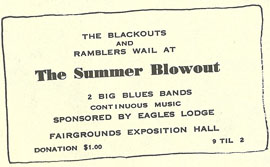
The Blackouts
and
Ramblers wail at
The Summer Blowout
2 big blues band
Continuous music
Sponsored by Eagles Lodge
Fairgrounds Exposition Hall
Donation $1.00
9 til 2
June 22, 1957—The Blackouts At The NAACP 7th Annual Festival, Shrine Exposition Hall
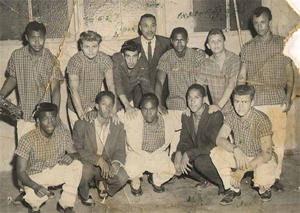
This picture appeared on the Internet around February, 2001.
When I moved to Lancaster I put my own band together, called the Blackouts, and I was still playing drums. The biggest gig we ever had was at the Shrine Exposition Hall for an NAACP benefit; we were the warm-up act to Earl Bostic. The people weren't dancing to Earl Bostic for some reason, so he hung it up, and we went back out there and played. Everybody was jumping all over the place.
I found this article and ad dated on June 13, 1957 (the ad is repeated on June 20, 1957) where I think the Blackouts opened for Earl Bostic Orchestra at the Shrine Exposition Hall on June 22, 1957. Other artists included were: Red Nichols and his Five Pennies, the Velvetones, Little Richard & The Platters.
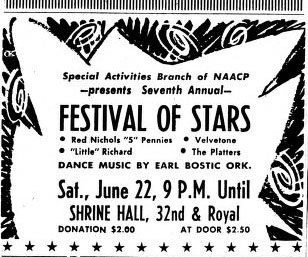
Special Activities Branch of NAACP
—presents Seventh Annual—
FESTIVAL OF STARS
Red Nichols "5" Pennies
Velvetones
"Little" Richard
The Platters
Dance Music by Earl Bostic Ork.
Sat., June 22, 9 P.M. Until
Shrine Hall, 32nd & Royal
Donation $2.00
At door $2.50
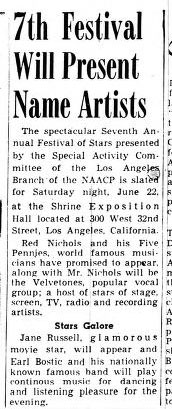
7th Festival Will Present Name Artists
The spectacular Seventh Annual Festival of Stars presented by the Special Activity Committee of the Los Angeles Branch of the NAACP is slated for Saturday night, June 22, at the Shrine Exposition Hall located at 300 West 32nd Street, Los Angeles, California.
Red Nichols and his Five Pennies, world famous musicians have promised to appear, along with Mr. Nichols will be the Velvetones, popular vocal group; a host of stars of stage, screen, TV, radio and recording artists.
Stars Galore
Jane Russell, glamorous movie star, will appear and Earl Bostic and his nationally known famous band will play continous music for dancing and listening pleasure for the evening.

"LITTLE" RICHARD, recording artist, has consented to appear as one of the guests on the NAACP Festival of Stars show, Shrine Hall, Royal at 32nd Street, Saturday, June 22, 9 p.m. to 1 a.m. Other performers will be Lena Horne, starlet Lena Ayo, Earl Bostic's ork., Louis Armstrong, Jackie Cain and Roy Kral.
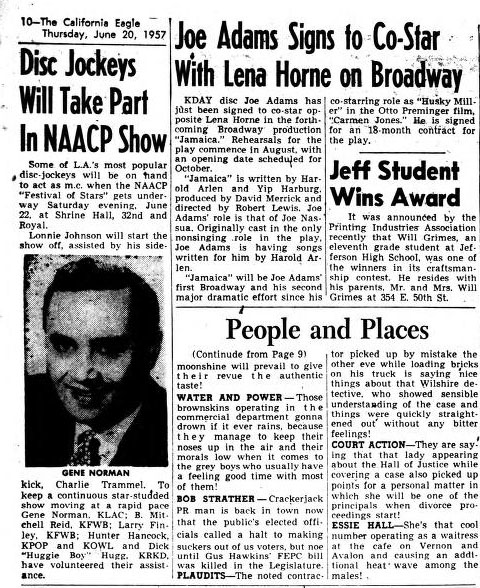
Disc Jockeys Will Take Part In NAACP Show
Some of L.A.'s most popular disc-jockeys will be on hand to act as m.c. when the NAACP "Festival of Stars" gets underway Saturday evening, June 22, at Shrine Ahll, 32nd and Royal.
Lonnie Johnson will start the show off, assisted by his sidekick, Charlie Trammel. To keep a continuous star-studded show moving at a rapid pace Gene Norman, KLAC; B. Mitchell Reid, KFWB; Larry Finnley, KFWB; Hunter Hancock, KPOP and KOWL and Dick "Huggie Boy" Hugg, KRKD, have volunteered their assistance.
Charles Ulrich, August 28, 2012
Thirteen minutes into the 9/13/70 Miles interview, FZ says that when The Blackouts opened for Earl Bostic at the Shrine Auditorium, they were an eight-piece band. "One guy was half Sicilian and half Indian. We had two Mexicans. And me and one other guy were the whiteys in the band. And all the rest of the guys were black."
The Sicilian-Indian Blackout must have been [Elwood "Junior"] Madeo. Miles (p. 28) says that Madeo was "also known as 'Bomba the Jungle Boy' because of his Indian-Italian parentage."
Charles Ulrich, May 15, 2013
I think "Charles Reeves" of The Blackouts is really Charlie Reid Jr. of the AVJUHS class of '57 [see detail below]. [...] I think Charlie Reid is in the front row next to Ernie Thomas. [...] Javier Marcote [...] agrees that these two photos show the same person. [...] If that's Charlie Reid, then Sonny [Lewis] must be between him and Wayne Lyles. And the unidentified Blackout next to Elwood Madeo may be Steve Wolfe.
Sharva Maynard, February 13, 2007
Regarding the band photo: Terry Wimberly is second from left, top row. Jerry Reutter is front row right end. [...] Fred and Wally [Salazar] are not in that band photo.
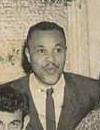
Joe Adams
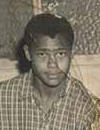

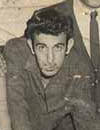
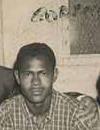

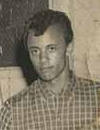
Johnny Franklin, Terry Wimberly, Frank Zappa, Carter Franklin, unidentified, Elwood Madeo.



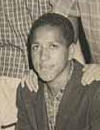
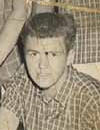
Ernie Thomas, Charlie Reid Jr., Freddy "Sonny" Lewis, Wayne Lyles, Jerry Reutter.
Charles Ulrich, August 23, 2014
[John Franklin] confirmed all of Román's identifications of the band members in the photo with Joe Adams. But unfortunately he didn't recognize the guy next to Elwood Madeo. He said it could be Stan "Corky" Mitchell (previously mentioned as a member of The Omens, not The Blackouts).
He identified Charles Reid as "guest vocalist" and Freddie Lewis as "equipment facilitator".
Some friends of The Blackouts
Frank had a band at that time called the Blackouts. I went over and saw them at the Moose Lodge or something, and the group disbanded right after that.
Bill Harkleroad, interviewed by Joe Gore, Guitar Player Magazine, January 1, 1998
One of the first bands I remember seeing live was the Blackouts with Frank on drums. When I was 14 or 15 and Frank and Don [Van Vliet] were in their early 20s, I started meeting them at jam sessions.
Bill Harkleroad, interviewed by David Gabrielsen, DISCoveries vol.1 #7, December 1, 1988
I grew up in the same town [as Don Van Vliet]. I used to see his group and Zappa, when he was just starting out, in a group called The Blackouts, playing dynamite blues guitar. They would rehearse in the Junior High gymnasium, and I'd sneak in and listen to them. Here were these old guys and a nineteen-year-old playing this blues music.
The first time I ever heard a live band was in an assembly at Antelope Valley Joint Union High School (AVJUHS). The band was The Blackouts: Frank Zappa on drums; Terry Wimberly on piano; Fred [Salazar] on baritone sax; Fred's brother Wally on guitar; and three soulful vocalists, Henry Strawberry, Chuck Spencer, and a third singer whose name I don't recall at the moment but I will get it from my yearbook. At the time that was the first mixed band I or anyone else had EVER seen. From that time on I knew exactly what I wanted to do in my life.
I was just the guy who got them from point A to point B. I was not in the band at all. I didn't play anything. I was transport. I remember Wally Salazar . . . Terry Wimberly . . . Frank, drums. Who knows bass? I don't even know if there was one.
I got connected in all this when I was a freshman in High School and Frank was a senior. [...] I was studying radio and electronics, and stuff. It was my nature. I met this guy—Steve Wolfe's brother. He was kind of a nerd, an electronics geek. I went over to his house one time and his brother Steve was a sax player in The Blackouts. [...]
Frank was the drummer. I guess Terry Wimberly was in there and Johnny Franklin and you know all the others. I had always been interested in music and playing an instrument but I never had gotten close enough to get my hands on an instrument, or close enough to where I could get into it. [...] Anyway, I went over there and (The Blackouts) were having a band practice at Steve's house—so I got to meet the band. Steve Wolfe, the sax player and I struck up a friendship. I used to hang out, and every time there was a practice, I'd go to their practice, and I'd go to their gigs and stuff. I even cut school a couple of times to go to their gigs. I remember getting in trouble for it.
Yucca 1957 (AVHS Yearbook)
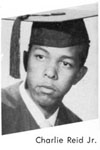
Charlie Reid Jr.

Row I, left to right: Mable Macgibbon, Joyce Lumbey, Ann Howell, Charles Bonner, Russ Klingerman, Bruce Miles, Cal Calvert, James McGee, Judy Brown, Margie Farmer, Mary Jay, Thelma Dunn, Bill Hoggett. Row II, left to right: Diane Shuls, Genel Kyle, Pat Orsborn, Evelyn Biscayart, Sam Ponton, Charles Reid, Alfred Elliott, John Franklin, Leroy Avila, Wayne Lyles, Hasel Bonner, Nancy Erstad, Amanda Kasperson, Beverly Kasperson. Row III, left to right: Theo Barker, Diane Marston, Beverly Shaw, Barbara Payne, Marie Mulligan, Harry Bumgardner, Charles Spencer, Jonas Lamb, Wayne Kime, Bill Reilly, Pat Diutsman, Kathy Greggs, Carolyn Thanpson. Row IV, left to right: Nada Lapossa, Georgin Dekom, Myrna Ackerman, Kathleen Klingerman, Jane Lockhard, Don Gasline, David Todd, Clifford Jordan, Richard Nygaard, Rudy O'toole, Penelope Rich, Brenda Buedil, Dora Beale, Donna Griffin.

[Charles Spencer, Charles Reid, John Franklin, Wayne Lyles]
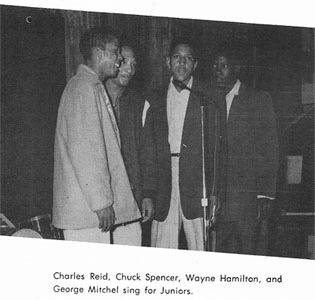
Charles Reid, Chuck Spencer, Wayne Hamilton [Lyles], and George Mitchel sing for Juniors.

[Denny Walley]
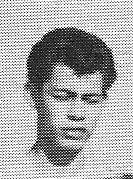
[Fred Salazar]
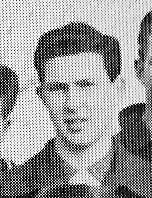
Rex Jakabosky
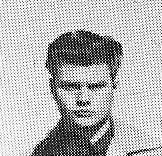
[Terry Wimberly]
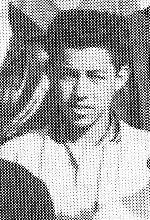
[Walter Salazar]
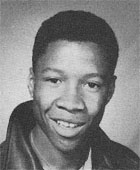
[Henry Strawberry]
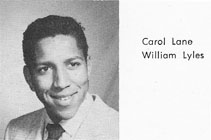
William Lyles
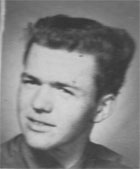
[Jerry Reutter]
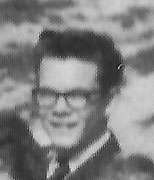
[Senior Band] WOODWINDS: [...] Steve Wolfe
August, 1957—Baltimore, MD
[FZ] wanted to see some of the world, and his mother suggested a trip back to Baltimore to visit his relatives. Frank wrote Aunt Mary to get the OK.
"Besides sending thanks, this letter is going to be kind of a questionnaire," he wrote. "The question being, 'Could you find some space for me if I were to come and visit you and Uncle Robert?' . . . The reason for the trip is two-fold. Firstly, I would like to see the East again and all the relatives (most of which I probably couldn't recognize by face at all) back there.
"The second reason is that I think I have invented something new in the way of music (probably not) which I would like to take to the conservatory back there for investigation. If I did come I would not stay long, and I would help out around the house any way I could, so please consider this request and write soon."
Aunt Mary opened her home at 4805 Loch Raven Blvd. to her nephew and soon Zappa was traveling the length of the country on a train. Finally emerging from Penn Station, he said that:
"My relatives were shocked to see the way I looked. They were all so horrified that I think I was an embarrassment to them.
[...] Zappa hoped to travel to New York to visit French-born composer Edgar Varèse (1883-1965), an early and perhaps most major influence, during his East Coast trip, but the older man was not available.
[...] An insufficient consolation, however, was an introduction to Massimo Freccia, at the time the conductor of the Baltimore Symphony Orchestra, now in retirement in London.
He brought along his "new" music, a foreshadowing of the trademark Zappa pastiche of this and that, culled from here and there.
"I had brought manuscript paper to Maryland and was writing orchestra music at Aunt Mary's house," he said. "I was naive and thought [Freccia] could play it. He looked at [my appearance] and couldn't believe I was writing orchestra music."
Instead of discussing the earnest but somewhat crude Zappa compositions, Freccia instead quizzed the youngster with questions like: "What's the lowest note on the bassoon?" The relationship ended there.
December 4, 1957
On 4 December 1957, just before his seventeenth birthday, [FZ] sold part of his drumming equipment, and hired out another part to another local band called The Bluenotes; the contract for that deal is another of the biographical artefacts Zappa has kept to this day.
April 19, 1958—"Family Room"
Winner of the state wide art competition sponsored jointly by the California Federation of Women's clubs and the Hallmark Greeting Card company is Frank Zappa of Lancaster, son of Mr. and Mrs. Frank Zappa, 45438 Third St. East.
Young Zappa was the honored guest Saturday at a tea in the Jack Carr galleries in South Pasadena where he was presented with the award for his painting. An abstract, it is entitled "Family Room." [...]
Currently, he is in Shirley Eilers' class at the Lancaster high school.
[...] A performer on the drums, vibes and guitar, he is the former leader of the jazz combo known as the "Blackouts."
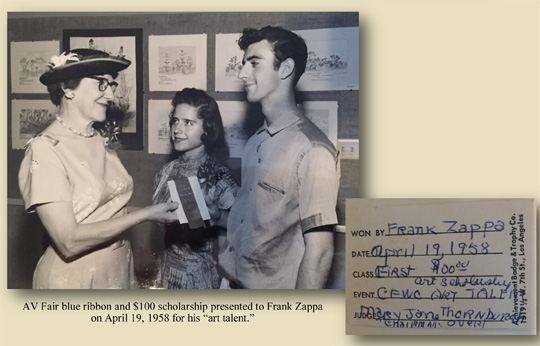
AV Fair blue ribbon and $100 scholarship presented to Frank Zappa on April 19, 1958 for his "art talent."
WON BY Frank Zappa
DATE April 19, 1958
CLASS First $100.00 art scholarship
EVENT CFWC Art Talent
JUDGES Mary Jane Thornburg chairman (over)
June 13, 1958—Graduation
I graduated from Antelope Valley High School, Lancaster, California on Friday, June 13, 1958 (with about twenty units less than what was required, simply because they were in a hurry to get rid of me)—
I remember well the night he graduated from high school. It was 1958. We were all dressed up in our Sunday-go-to-meetin' clothes and I was so happy to see Frank in that cap and gown. It was quite a change from the chinos and T-shirts that he always wore. He was smiling and waving his diploma.
The following information is gleaned from a radio show Frank is putting together for distribution. [...] Frank began playing guitar in 1958. He graduated from high school the same year and attended one semester of Jr. College before "finding someone to live with and dropping out."
1958 Antelope Valley High School Book

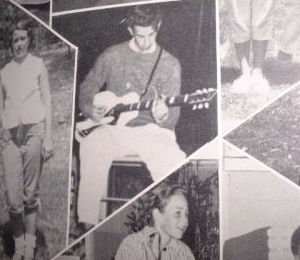
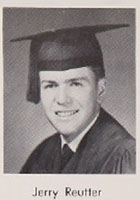
Jerry Reutter
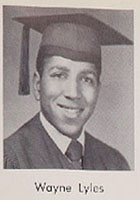
Wayne Lyles
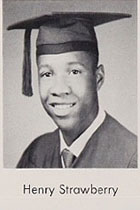
Henry Strawberry
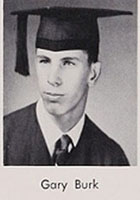
Gary Burk [Gary Burkey?]
1960 Supro Dual Tone, manufactured by Valco
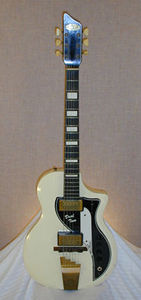

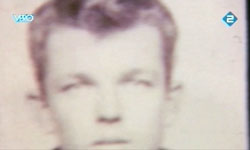
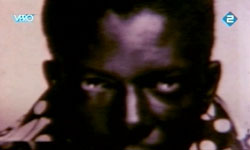

[Junior Madeo, Don Vliet?, Ernie Thomas?, ?]
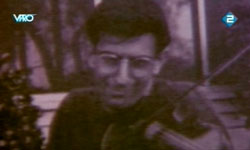
[unidentified violinist: FZ?]
June-July, 1958—Idyllwild School Of Music And The Arts
[Mrs. Amy] Heydorn was Instrumental with getting a Junior College Art Scholarship for Frank.
Yucca 1957 (AVHS Yearbook)
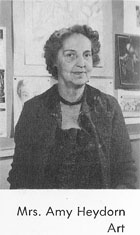
Mrs. Amy Heydorn
Art
Highly versatile, young Zappa does not confine his artistic pursuits to painting although he will study at Idylwild this summer on a scholarship obtained through the good offices of Mrs. Amy Heydorn, Antelope Valley high school teacher under whom he has studied.
"Special High School Workshops Set This Summer At Idyllwild Arts Foundation," Desert Sun, May 29, 1958
In an effort to meet the needs of high school students who have shown an interest in the adult classes at the Idyllwild Arts Foundation, Idyllwild, California, in past seasons, special high school workshops will be presented for this age group this season.
Beginning June 23, three two-week Art Workshops will be open to high school students who have demonstrated interest and ability in art. They will receive six hours of instruction daily from regular members of the Art Faculty.
THE CALIFORNIA Federation of Women's Clubs has a "Penny Art Fund" to make scholarship awards to high school students and this year Frank Zappa, at Lancaster High School has been awarded first prize, according to Mary Jane Thornburgh.
The two Dance Workshops beginning July 14 are open to students who are interested in dance whether or not they have had previous instruction. High school students who wish to learn to sing folk songs or to learn to accompany themselves on guitar, may enroll for the High School section of the Folk Music Workshop which begins July 7.
The Ash Grove features ETHNIC ETHNICAL ETHNOCENTRIC Folque Musique . . . I remember when Bud & Travis used to work there and Ed Pearl used to do Ethnopolitical Greasing for the newly founded cabaret at the Idyllwild Folk Freak Sanctuary in 1958, Before Hal Zeiger invented the HOOTENANNY.
Charles Ulrich, July 23, 2007
Marina Bokelman was a guitarist who met FZ in the summer of 1958, when he was attending the Idyllwild School Of Music And The Arts on an art scholarship. They performed together at gatherings at her parents' house.
Additional informants: Tan Mitsugu, Javier Marcote (special thanks to Javier for finding and providing so much material), Michael Dawson

















































